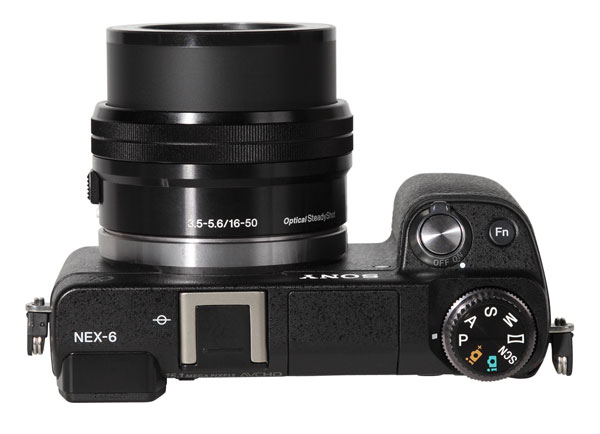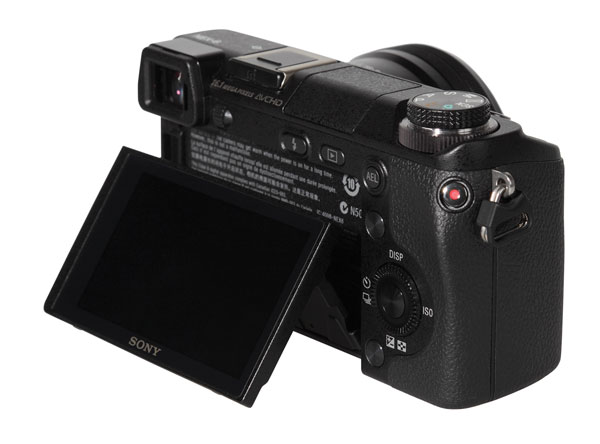Sony NEX-6 Review
The NEX-6 offers an APS-C-sized CMOS sensor with 16MP resolution, the Sony NEX E-mount system, a large swivel screen on the back, a high-resolution electronic viewfinder, and a Wi-Fi module for wireless data transfer or remote control. This very small system camera uses a large mode dial on the top to set up exposure modes directly instead of using the menu on the screen (unlike other NEX cameras). Directly below this mode dial there is an additional dial to change image parameters. The photographer can use this second dial and the third dial (which encircles the cursor field) to change aperture and shutter speed settings directly, which makes it as comfortable to operate as an SLR system.





The camera has a high-resolution OLED viewfinder that offers a very crisp and brilliant image. In addition to the high resolution, a “focus peaking” function helps to set up manual focus easily and quickly.
The NEX-6 has an integrated flash that can be used as fill-in for portraits and other close-up work. A sophisticated pop-up mechanism flips the flash high above the optical axis to prevent redeye; the camera also has a hot shoe for additional flash systems. Just like the Sony Alpha SLT-A99, it’s a standard shoe instead of the Sony/Konica-Minolta ADI system.
The camera offers a swivel monitor which allows the user to flip the screen up- and downward. A light sensor is used to switch automatically between OLED screen and viewfinder; when the photographer looks through the viewfinder’s eyepiece/ocular the rear monitor blanks out.
The camera has a Wi-Fi module that offers remote control function (via smartphone) and image data transfer to a PC or a smartphone. In addition, the camera can use special imaging apps, via download, which are available in Sony’s app store. Some of these applications are free while others like the Multiframe-RM (which allows the user to shoot an image series and combine these single frames to a noise-free picture) are for sale. The photographer can select these additional apps by choosing the “Application” button on the screen.
The camera offers Full HD video capability with high frame and bit rates. It is able to record up to 50 frames per second with up to 28 Mbit/s. In addition, it offers smaller MP4 video files (up to 1280x720 pixels) for direct Internet upload.



Image Quality
Color: The camera showed good performance in our color tests. The images are well saturated (101.2 percent) and don’t get the “heightened” look of images taken with older Sony cameras. The skin tones are very fine and optimized by a slight shift into the orange- and magenta-colored areas (even pale skin will get a “more tanned look”). The automatic white balance system worked well under both natural and tungsten light; fluorescent light causes a shift into the yellow- and green-colored areas, noticeable in the bright background of our portrait shot and the gray background of the standard test box shot.
Sharpness: Just like in images taken with nearly all NEX models, the resolution results of the NEX-6 are a little bit low. We used the new 16-50mm lens for the resolution tests and gained a maximum of 2546 lines per picture height in our images; the sensor has a nominal resolution of 3264 lines in picture height. Nevertheless, the images have a crisp look because the USM filtering is high, but still acceptable. Sometimes the sharpness filtering causes a slightly artificial look, as you can see in the structure of the hair in our portrait test shot. The differentiation of red nuances is very good: the structure of the red fabric in the portrait shot is noticeable.
Noise: The Sony showed a good performance in our noise tests. Luminance noise is a little high at the lowest ISO speed settings but stays on this level up to ISO 800 because the camera increases anti-noise filtering as ISO is heightened. Color noise is acceptable up to ISO 6400, even though color clouds/color smear is already visible in homogeneous-colored areas (but still tolerable). At the highest speed of ISO 25,600 the anti-noise filtering is extreme and softens contrast lines between the gray patterns of the test chart. The result is that gray patterns become a kind of gray gradient with clearly visible color spots. We feel that the highest ISO settings of 12,800 and 25,600 should only be used when absolutely necessary. The dynamic range is on an average level for system cameras. The NEX-6 gained a maximum of 10.3 f/stops.
The Sony NEX-6 with the 16-50mm kit lens has a list price of $999. For more information, visit www.sony.com.
Scorecard
Pro
+ Very compact system camera
+ High-resolution viewfinder, swivel monitor
+ Full HD video, including AVCHD 2.0 modes (high frame rate, high bit rate)
+ Built-in flash system; standard hot shoe (instead of ADI shoe)
Con
- Missing microphone interface for better sound recording
Lab results and test images by BetterNet, our TIPA-affiliated testing lab. Edited by George Schaub.
Image Tech is where we publish web-exclusive lab reports on cameras. To read the reports please go to the Shutterbug homepage at www.shutterbug.com and click on the Image Tech tab on the top navigation bar. New reports are published frequently, so check Image Tech for updates.
- Log in or register to post comments

















































